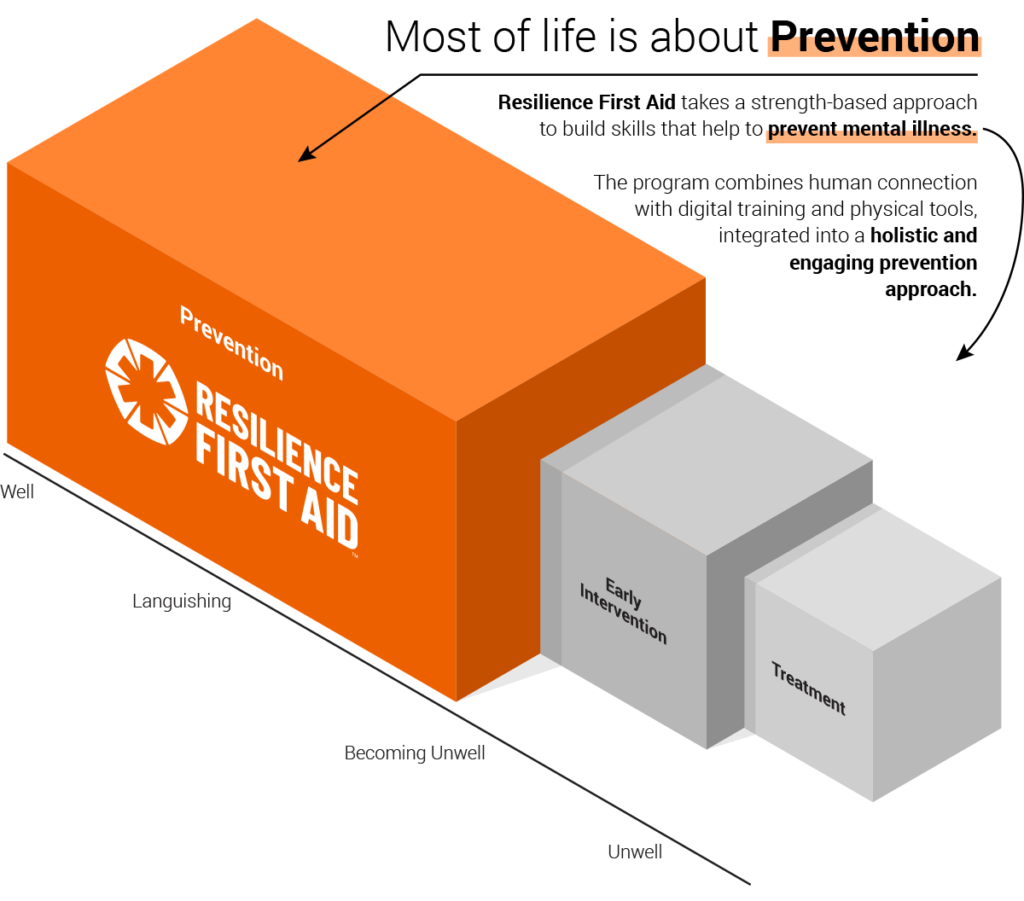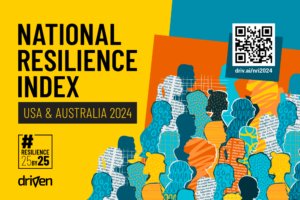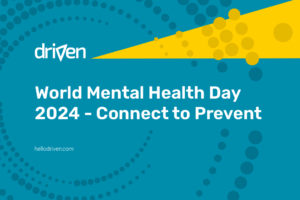Mental Health Month 2024 – Shift to Primary Prevention
Key Points:
- 🔄 May 2024 – Workplaces are shifting focus to primary prevention in mental health
- ❗ What are the shortcomings of crisis intervention, and why we need to shift
- 📈 Primary prevention builds resilience, prevents issues before they occur
- 🚀 See a practical approach to start shifting to primary prevention
May is Mental Health Month, and as we work our way through 2024, the importance of mental health in the workplace is becoming increasingly apparent. We’re increasingly seeing workplaces become enlightened in their approach to mental health. How? By shifting towards primary prevention. Generally, whenever we talk about prevention in mental health, what we mean is primary prevention, so I though it would be helpful to expand on what this concept really means.
Understanding Primary Prevention
Primary prevention in mental health involves strategies and interventions designed to pre-empt the onset of mental health issues before they manifest. This proactive approach focuses on enhancing individual resilience, fostering a supportive environment, and promoting mental well-being to lower the incidence and impact of mental health problems. This has a strong overlap with managing psychosocial hazards in the workplace.
Unlike reactive strategies, primary prevention targets the entire population, aiming to improve the overall mental health landscape by addressing potential risk factors and strengthening protective factors.
Contrast with Crisis Intervention
Crisis intervention, traditionally the cornerstone of mental health responses, is significantly different from primary prevention. This approach is characterised by the immediate and urgent treatment of acute mental health crises (for example, intervening to stop self-harm or suicide).
While effective in stabilising severe situations, crisis intervention is often resource-intensive and does not prevent the primary occurrence of mental health issues. This typically engages individuals only after a problem has become evident, which can lead to repeated crises and a cycle of dependency on emergency care.
Shortcomings of Crisis Intervention
Crisis intervention, although necessary, has several limitations:
- Reactivity – It addresses issues only after they have developed, missing the opportunity to prevent problems
- Resource Intensive – Managing crises requires significant resources, which could otherwise be allocated to more sustainable preventive measures
- Limited Scope – This method often focuses on individuals rather than the community or population, potentially overlooking broader systemic issues that contribute to mental health problems
- Saturation – An interesting aspect is that a huge number of people have already completed crisis intervention training, and subsequently, we haven’t seen much improvement in general mental health nor a reduction in trends. This is why we need to shift to primary prevention
Importance of Primary Prevention
As the burden of mental health issues grows globally, the importance of primary prevention becomes increasingly apparent. By intervening early, primary prevention can:
- Reduce the overall incidence of mental health issues – By addressing root causes and early indicators, fewer individuals may develop severe conditions
- Promote a healthier community – Community-wide preventive measures can lead to a more resilient and mentally healthy sense of community
- Save on long-term healthcare costs – Preventing mental health issues can reduce the need for expensive, long-term treatment options and decrease the economic burden on healthcare systems
Benefits of Primary Prevention in the Workplace
Implementing primary prevention in the workplace can transform the mental health of the workforce. Organisations that invest in the mental well-being of their employees not only enhance individual lives but also achieve significant organisational benefits:
- Improved Productivity – Employees in good mental health are more productive and engaged
- Reduced Absenteeism and Presenteeism – Preventing mental health issues can decrease both the occurrence of employees missing work due to illness and the instances of employees attending work while unwell
- Enhanced Workplace Culture – A focus on mental well-being contributes to a positive workplace environment, fostering better relationships and collaboration
- Cost-Effective – By reducing the incidence of mental health issues, organisations can avoid the costs associated with crisis interventions and long-term treatments
The shift towards primary prevention in mental health represents a pivotal change in our approach to health care. It offers a sustainable, effective, and humane alternative to crisis intervention, aiming not just to treat mental illness but to prevent it altogether. As society progresses, the emphasis on preventive care in mental health is not only beneficial but essential for fostering a healthier future.
Resilience as a Proven Primary Prevention Strategy
One effective way to implement primary prevention in the workplace is through resilience programs. The Certified Resilient Workplace program is a comprehensive initiative designed to foster a mentally healthy work environment. This program equips organisations with the tools and knowledge necessary to build resilience and support employee well-being.
A key component of the Certified Resilient Workplace program is Resilience First Aid. This innovative approach empowers employees to support one another, creating a network of peer support within the organisation. By providing employees with the skills to recognise and respond to signs of mental distress in their colleagues, Resilience First Aid promotes early intervention and helps prevent minor issues from escalating into more serious problems.
The Role of Employers in Promoting Primary Prevention
Employers play a crucial role in promoting primary prevention in the workplace. By creating a supportive and open culture that encourages conversations about mental health, organisations can break down stigmas and foster an environment where employees feel comfortable seeking help. Investing in employee mental health and well-being, providing access to resources and training, and leading by example are all essential steps employers can take to prioritise primary prevention.
Shifting Into the Future
As we move forward into 2024, the importance of primary prevention in workplace mental health cannot be overstated. By adopting a proactive approach and implementing resilience programs like the Certified Resilient Workplace and Resilience First Aid, organisations can create mentally healthy workplaces that support employee well-being. The potential for positive change extends beyond the workplace, as individuals who are equipped with the tools to build resilience can apply these skills to their personal lives as well.
Practical Primary Prevention
Take the first step towards embracing the future of workplace mental health today by following these actionable steps:
- Spread broad resilience and psychosocial risk awareness with the RFAST program – Begin your journey by educating your workforce about the importance of resilience and the potential psychosocial risks they may face. The Resilience First Aid Starter Training (RFAST) program provides a solid foundation for your employees to understand and prioritise their mental well-being
- Embed resilience champions with the Resilience First Aid program – Identify and train a group of employees to become resilience champions within your organisation. The Resilience First Aid program equips these individuals with the skills and knowledge to support their colleagues, promote early intervention, and build a culture of peer support
- Commit to a long-term journey of prevention and safety by joining the Certified Resilient Workplace program – Take your commitment to the next level by enrolling in the Certified Resilient Workplace program. This comprehensive initiative provides ongoing support, resources, and guidance to help your organisation establish and maintain a mentally healthy work environment. By joining this program, you demonstrate your dedication to the well-being of your employees and position your organisation as a leader in workplace mental health
By implementing these steps, you can make a meaningful difference in the lives of your employees and contribute to a healthier, more resilient workforce. Embrace the future of workplace mental health and take action today by learning more about the Certified Resilient Workplace program and Resilience First Aid.




